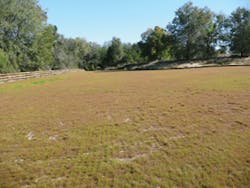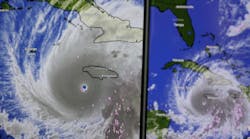The installation of a permeable surface in a parking area at a newly developed Florida recreation spot is helping park managers provide an aesthetically pleasing look to the lot, while providing optimal onsite stormwater retention.
Ferndale Preserve is a 192-acre park in Ferndale, FL, located on the western shore of Lake Apopka in the central part of the state. The park, which is slated to open around the beginning of 2009, has three trails that offer vistas of Lake Apopka: a 2.5-mile nature and hiking trail, a 2.9-mile equestrian trail, and a 1.6-mile unpaved multipurpose trail. On a clear day, one can see downtown Orlando.
The former orange grove is being restored to a long-leaf pine and wiregrass ecosystem. Long-needled and large-coned trees characterize such an ecosystem with wiregrass as primary ground cover on a sand hill system with native wildflowers dispersed throughout.
“If you’ve ever driven through part of the Ocala National Forest, that’s what it would look like with sparsely populated tall trees,” says Tom Eicher, manager of parks and trails for Lake County. “Although these aren’t going to start that way, that’s what we’re aiming for.”
Ferndale Preserve’s history dates back before the 1940s, when the land had been converted into a citrus grove. Part of it had been used for a truck farm in the 1940s, says Eicher.
“The property was basically agricultural, so everything that originally had been there had been wiped out,” he explains.
At Ferndale Preserve, visitors may be able to spot one of 110 species birds; 40 types of butterflies; animals such as the pine snake, gopher tortoise, bobcat, river otter, American alligator, box turtle, and fence lizard; and many native plants, including an endangered small tree species, the silver buckthorn.
Plans call for a fishing pier and observation tower on Lake Apopka, a scenic pavilion overlook and a short boardwalk through the wet deciduous woodland.
The county has several goals before opening the park, including establishing portable sanitation and building an education pavilion. It also wants to establish grass in the parking area, which was surfaced with 26,000 square feet of Soil Retentions’ Drivable Grass.
Drivable Grass, a concrete-based flexible and permeable pavement product, allows stormwater to filter through into the subsurface. In areas such as Florida, which can be prone to drought, the stormwater is retained on the property and in Florida’s high water table.
The product is designed to flex and conform to irregular ground surface contours along predefined linear grooves. Root penetration takes place through premanufactured holes and cracks down into the subgrade soil.
The mat’s porous nature allows moisture to filter into the underlying soil, increasing onsite stormwater storage, and minimizing offsite water flow.
“Last summer, when it was wicked hot, our contractors put the Drivable Grass down. They did everything they were supposed to do: They hydroseeded it, they watered it a couple of times,” says Eicher. “But they didn’t water enough, waiting for summer rains, and we never got them last year. Then we did get some [rain]–all of a sudden, we got two inches in two hours and the hydroseeding washed away.“So they came in and tried it again. We had the same thing happen again, so we decided to wait until fall [2007] and throw some annual ryegrass in there to get something established, then come back in during the growing season, which started in spring, and replant.”
County officials are waiting for that grass to come up.
“In the meantime, we’ve got a temporary watering system in case the weather doesn’t help us out,” says Eicher. As of late spring, the weather was still rather dry.
Ferndale Preserve sits atop a ridge. The parking lot elevation is about 90 feet above sea level. From there, the land slopes up to the highest point east toward Lake Apopka, where there is an elevation change of about 165 feet, offering the scenic vistas. The property then drops down to about 65 to 70 feet at Lake Apopka.
“The parking lot itself is on the back side of the hill,” says Eicher. Therefore, stormwater concerns are not affiliated with runoff, but rather, potential flooding issues in the parking area.
The Drivable Grass installation went smoothly, Eicher notes. “Basically, it was getting the parking lot graded to where we wanted, putting down the base material that was required for the Drivable Grass, and mowing it,” he says. “It really wasn’t that difficult.”
The Drivable Grass mats installed measure 2 feet by 4 feet and weigh about 95 pounds apiece. Soil Retention has since switched to a 2-foot-square mat, primarily because of the weight, Eicher notes.
Eicher describes the appearance and function of the mats as such: “If you take a cupcake tin and turn it upside down, and in between the areas of the raised portion of the cupcake tin, you’ve got holes–that’s where the water seeps through.”
Drivable Grass allows contaminants, such as vehicle drippings, to filter through the aggregates installed below the product.
The grass grows in-between what are called “muffins.”
“You put organic material around the raised portion–the “˜muffin’–and that also helps grass grow and gives it something else to grow into,” says Eicher.
This option was selected for the lot based on testing that Soil Retention had performed by driving fire trucks on the product, says Eicher.
“We know with the equestrian trails, people are going to be pulling in with larger-than-normal trucks, pulling trailers with horses,” he says. “We had the added weight there that we normally don’t see in our parks, and we wanted to do something without creating huge retention ponds.”
The park features a few small retention ponds, but Eicher says they exist primarily to help collect some of the runoff from the concrete driveway; Drivable Grass is favored because it helps to create a pervious area for stormwater.
“This was the only option that really made sense,” says Eicher. “The area getting into the park is relatively soft sand, and if we did anything other than asphalt, people would be getting stuck and there would be problems. We contemplated just having grass, but that wouldn’t hold up, especially in the soft sand.”
Eicher notes that Ferndale Preserve may ultimately not have enough parking spaces and the county may have to purchase adjacent lots.
This is the first time the county has used Drivable Grass. The project stayed within budget, and the product has proven to be an appropriate benchmark for future consideration, Eicher says.
Other than having to cut the grass after it grows, the Drivable Grass requires no other maintenance, says Eicher.
“It should give us the look for a place that’s called a preserve,” he says. “We think it’s going to be beautiful.”


